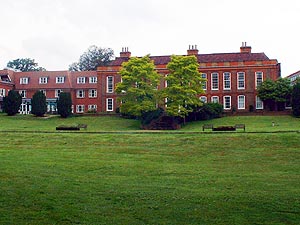Harold Gillies
Harold Gillies
Harold Gillies (17 June 1882 – 10 September 1960) was a pioneering New Zealand-born plastic surgeon who is widely considered the father of modern plastic surgery. He is best known for his innovative work in reconstructive surgery during and after World War I.
Early Life and Education[edit | edit source]
Harold Delf Gillies was born in Dunedin, New Zealand, and later moved to England for his education. He attended Wanganui Collegiate School and later studied medicine at Gonville and Caius College, Cambridge. After completing his medical degree, he trained as a surgeon at St Bartholomew's Hospital in London.
World War I Contributions[edit | edit source]
During World War I, Gillies joined the Royal Army Medical Corps and was posted to the Western Front. He was deeply moved by the severe facial injuries suffered by soldiers and recognized the need for specialized surgical techniques to address these injuries. In 1917, he established a dedicated plastic surgery unit at the Queen's Hospital in Sidcup, Kent, which became the world's first hospital dedicated to plastic surgery.
Gillies developed numerous innovative techniques for facial reconstruction, including the use of tubed pedicle flaps, which significantly improved the outcomes for patients with severe facial injuries. His work laid the foundation for modern reconstructive surgery and greatly advanced the field of plastic surgery.
Post-War Career[edit | edit source]
After the war, Gillies continued to advance the field of plastic surgery. He published several influential texts, including "Plastic Surgery of the Face" in 1920, which became a seminal work in the field. He also trained many surgeons from around the world, spreading his techniques and knowledge globally.
During World War II, Gillies once again played a crucial role in treating injured soldiers. He worked at Rooksdown House, part of Park Prewett Hospital in Basingstoke, where he continued to innovate and refine his surgical techniques.
Legacy[edit | edit source]
Harold Gillies' contributions to plastic surgery have had a lasting impact on the field. He is remembered as a compassionate and skilled surgeon who transformed the lives of countless patients. His pioneering work laid the groundwork for modern reconstructive surgery and has influenced generations of surgeons.
Personal Life[edit | edit source]
Gillies was married to Kathleen Margaret Jackson, and they had four children. He was also an accomplished golfer and enjoyed painting in his spare time.
See Also[edit | edit source]
- Plastic surgery
- Reconstructive surgery
- World War I
- Royal Army Medical Corps
- Queen's Hospital, Sidcup
References[edit | edit source]
External Links[edit | edit source]
Search WikiMD
Ad.Tired of being Overweight? Try W8MD's physician weight loss program.
Semaglutide (Ozempic / Wegovy and Tirzepatide (Mounjaro / Zepbound) available.
Advertise on WikiMD
|
WikiMD's Wellness Encyclopedia |
| Let Food Be Thy Medicine Medicine Thy Food - Hippocrates |
Translate this page: - East Asian
中文,
日本,
한국어,
South Asian
हिन्दी,
தமிழ்,
తెలుగు,
Urdu,
ಕನ್ನಡ,
Southeast Asian
Indonesian,
Vietnamese,
Thai,
မြန်မာဘာသာ,
বাংলা
European
español,
Deutsch,
français,
Greek,
português do Brasil,
polski,
română,
русский,
Nederlands,
norsk,
svenska,
suomi,
Italian
Middle Eastern & African
عربى,
Turkish,
Persian,
Hebrew,
Afrikaans,
isiZulu,
Kiswahili,
Other
Bulgarian,
Hungarian,
Czech,
Swedish,
മലയാളം,
मराठी,
ਪੰਜਾਬੀ,
ગુજરાતી,
Portuguese,
Ukrainian
Medical Disclaimer: WikiMD is not a substitute for professional medical advice. The information on WikiMD is provided as an information resource only, may be incorrect, outdated or misleading, and is not to be used or relied on for any diagnostic or treatment purposes. Please consult your health care provider before making any healthcare decisions or for guidance about a specific medical condition. WikiMD expressly disclaims responsibility, and shall have no liability, for any damages, loss, injury, or liability whatsoever suffered as a result of your reliance on the information contained in this site. By visiting this site you agree to the foregoing terms and conditions, which may from time to time be changed or supplemented by WikiMD. If you do not agree to the foregoing terms and conditions, you should not enter or use this site. See full disclaimer.
Credits:Most images are courtesy of Wikimedia commons, and templates, categories Wikipedia, licensed under CC BY SA or similar.
Contributors: Prab R. Tumpati, MD




